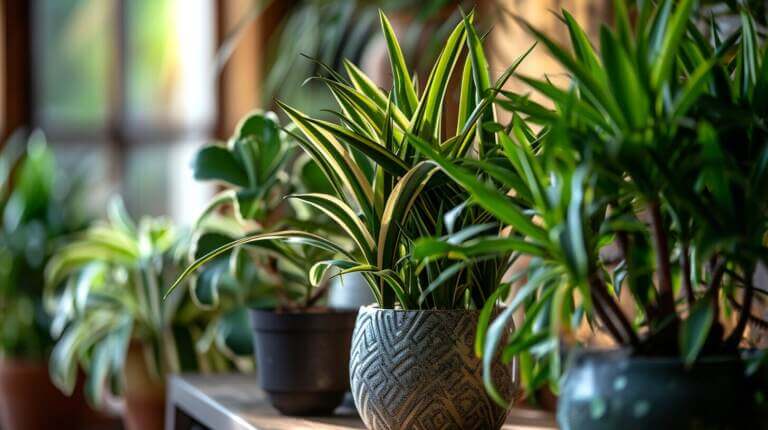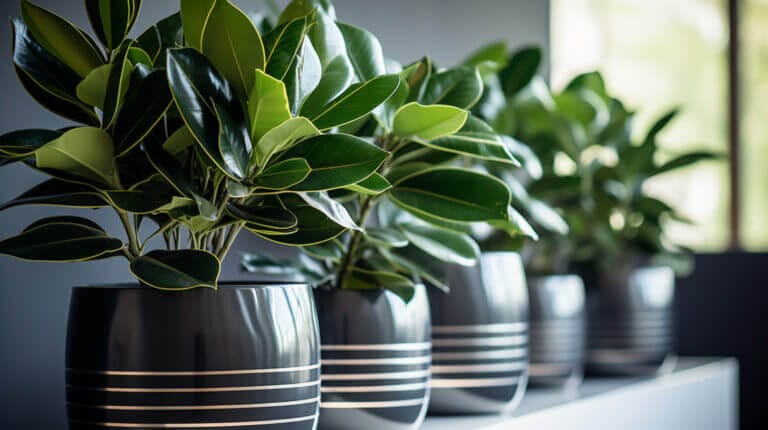Should a ZZ Plant(Zamioculcas Zamiifolia) Be Near a Window? Ideal ZZ Plant Placement
Have you ever wondered if a ZZ plant should be placed near a window? The ideal placement of a ZZ plant is a topic of interest for many plant enthusiasts.
In this informative article, we will explore the natural light requirements for a ZZ plant and the pros and cons of placing it near a window. We will also discuss alternative placement options and factors to consider when choosing the ideal spot for your ZZ plant.
Stay tuned for tips on maintaining healthy growth for your beloved plant.
Key Takeaways
- ZZ plants require a moderate amount of natural light and can be placed near a window.
- There are advantages and disadvantages to placing a ZZ plant near a window.
- Alternative placement options include well-lit rooms, rooms with artificial lighting, bathrooms, and office desks.
- Factors to consider when choosing ideal ZZ plant placement include indoor vs. outdoor placement and proximity to other plants.
Natural Light Requirements for a ZZ Plant(Zamioculcas Zamiifolia)
The ZZ plant requires a moderate amount of natural light to thrive, making it important to place it near a window that receives sufficient sunlight. Indoor plant care is crucial for the health and growth of houseplants, and understanding the light requirements of each plant is essential. The ZZ plant, also known as Zamioculcas zamiifolia, is one of the best houseplants for low-light conditions, but it still needs some exposure to natural light.
Placing a ZZ plant near a window allows it to receive the necessary amount of sunlight. Natural light provides the ZZ plant with energy for photosynthesis, which is vital for its growth and overall health. However, it is important to note that the ZZ plant can also tolerate lower light levels, making it a versatile choice for indoor spaces with limited access to sunlight.
While placing a ZZ plant near a window has its advantages, it also comes with some drawbacks. The pros and cons of placing a ZZ plant near a window will be discussed in the subsequent section, providing a comprehensive understanding of the best placement options for this popular houseplant.
Pros and Cons of Placing a ZZ Plant Near a Window
One potential advantage of placing a ZZ plant near a window is that it may receive an adequate amount of sunlight for optimal growth. Sunlight is crucial for the photosynthesis process, which allows plants to convert light energy into chemical energy. However, there are both advantages and disadvantages to consider when deciding whether to place a ZZ plant near a window.
Advantages:
- Increased access to natural light: Placing a ZZ plant near a window ensures that it receives direct sunlight, which is essential for its growth and health.
- Improved air circulation: Windows often provide a source of fresh air, promoting better air circulation around the plant.
- Aesthetic appeal: Placing a ZZ plant near a window can enhance the overall aesthetic of the room, adding a touch of greenery and natural beauty.
- Psychological benefits: Having a ZZ plant near a window can provide a sense of connection with nature, promoting relaxation and reducing stress.
- Potential for blooming: Adequate sunlight exposure can stimulate the ZZ plant to produce flowers, adding a burst of color to the room.
Disadvantages:
- Temperature fluctuations: Windows can expose plants to temperature fluctuations, which may be harmful to the ZZ plant.
- Intense sunlight: Direct sunlight can be too intense for ZZ plants, causing leaf burns or discoloration.
- Lack of privacy: Placing a ZZ plant near a window may compromise privacy, especially if the window faces a busy street or neighboring buildings.
- Potential for pests: Windows can serve as entry points for pests, increasing the risk of infestation in the ZZ plant.
- Limited space: Placing a ZZ plant near a window may limit available space for other furniture or decor items.
Alternative Placement Options for a ZZ Zamiifolia Plant
Several alternative placement options can be considered for a ZZ plant, allowing for flexibility in finding the optimal location for its growth. While placing a ZZ plant near a window can provide it with indirect sunlight, there are other placement options to consider for indoor gardening enthusiasts.
One alternative placement option is placing the ZZ plant in a well-lit room away from direct sunlight. This can be achieved by placing the plant near a bright, but not directly facing, window. This allows the plant to receive sufficient light without the risk of sunburn or excessive heat exposure. Another option is placing the ZZ plant in a room with artificial lighting, such as fluorescent or LED lights. These lights can provide the necessary light intensity for the plant’s growth, making it a suitable alternative for those without access to natural sunlight.
Here is a table showcasing different alternative placement options for a ZZ plant:
| Placement Option | Description |
|---|---|
| Near a window | Provides indirect sunlight, but risk of sunburn |
| Bright room | Well-lit room away from direct sunlight |
| Artificial light | Room with fluorescent or LED lights |
| Bathroom | High humidity and low light conditions |
| Office desk | Controlled lighting and temperature |
Factors to Consider When Choosing Ideal ZZ Plant Placement
When choosing ideal ZZ plant placement, it is important to consider factors such as light intensity and proximity to other plants. The placement of a ZZ plant can greatly affect its growth and overall health. Here are some factors to consider when deciding where to place your ZZ plant:
- Indoor vs. outdoor placement: ZZ plants are native to the forests of Eastern Africa, where they thrive in low-light conditions. Therefore, they are best suited for indoor placement in areas with indirect or filtered sunlight. Placing them outdoors in direct sunlight can lead to leaf burn and damage.
- Best locations for a ZZ plant in different rooms of the house: In the living room, a ZZ plant can be placed near a window with sheer curtains to provide filtered sunlight. In the bedroom, it can be placed on a nightstand or dresser to add a touch of greenery. In the bathroom, a ZZ plant can thrive due to the higher humidity levels. In the kitchen, it can be placed on a countertop away from direct sunlight.
- Proximity to other plants: ZZ plants are known for their ability to thrive in low-light conditions and their resistance to pest infestations. However, they can be sensitive to overwatering. Placing them near other plants can increase humidity levels and create a microclimate that promotes healthy growth.
Tips for Maintaining Healthy Growth in a ZZ Plant
To ensure optimal growth and health of your ZZ plant, it is crucial to implement key tips.
- Provide consistent moisture.
- Use well-draining soil.
- Maintain a temperature range between 65-75 degrees Fahrenheit.
When it comes to watering frequency, ZZ plants prefer slightly moist soil. Overwatering can lead to root rot, while underwatering can cause the leaves to become dry and brittle.
- Water the ZZ plant thoroughly, allowing the excess water to drain out of the pot.
- Wait until the top inch of soil feels dry before watering again.
In addition to watering, choosing the right soil is essential for the ZZ plant’s well-being.
- Well-draining soil is preferred to prevent waterlogging, which can lead to root rot.
- A mixture of regular potting soil and perlite or sand can help improve drainage.
ZZ plants are known for their resilience and ability to tolerate various conditions, but they are susceptible to a few common diseases.
- One of the most prevalent diseases is root rot, which is caused by overwatering or poorly draining soil.
- To prevent this, ensure proper watering and soil drainage.
- ZZ plants can also be affected by mealybugs and spider mites.
- Regularly inspect the plant for any signs of infestation, such as sticky residue or tiny webs, and treat accordingly with appropriate insecticides.
FAQS – ZZ Plant Care Guide
Can I Keep My ZZ Plant Near a Window Even If it Doesn’t Require Direct Sunlight?
The best light conditions for zz plant do not necessarily include direct sunlight. This hardy plant can thrive in low light levels and prefers indirect or filtered light. Placing it near a window without direct sun exposure is a great option to ensure healthy growth without causing any harm.
Does the ZZ Plant Require Direct Sunlight or Should It Be Kept Away from Windows?
The essential care guide for zz plants recommends keeping them away from direct sunlight. While they can tolerate low-light conditions, placing them near windows could lead to burning or scorching of their leaves. Opt for a location with indirect light to ensure their healthy growth and longevity.
Can a ZZ Plant Survive in Low Light Conditions?
A ZZ plant can survive in low light conditions, making it an ideal choice for indoor spaces with limited natural light. These plants are known for their ability to thrive in various lighting conditions, including low light environments. ZZ plants require minimal care and are considered one of the best low light plants. They can tolerate low light levels, making them perfect for offices or rooms with few windows.
Proper zz plant care tips include avoiding direct sunlight and providing moderate watering.
How Often Should I Rotate My ZZ Plant if It Is Placed Near a Window?
To ensure optimal growth and health of your ZZ plant, it is important to consider its ideal rotation frequency when placed near a window.
While the adage ‘a little goes a long way’ may apply, it is recommended to rotate your ZZ plant every 2-4 weeks to ensure even exposure to sunlight.
This will prevent the plant from leaning towards the window and promote balanced growth.
The impact of window light on ZZ plant growth can be significant, so regular rotation is essential.
Can I Place My ZZ Plant in a Bathroom Without Any Natural Light?
When considering placing a ZZ plant in a bathroom without natural light, it is important to understand its care requirements in low light conditions.
While ZZ plants can tolerate low light, they still need some indirect light to thrive. Bathrooms with artificial lighting or a small window can provide enough light for the plant. However, it is crucial to monitor the plant’s health and adjust its placement if it shows signs of stress or lack of growth.
Regularly dusting the plant’s leaves and using a well-draining potting mix can also support its growth in low light conditions.
Are There Any Specific Temperature Requirements for a ZZ Plant Placed Near a Window?
When considering the ideal placement for a ZZ plant, it is important to take into account its temperature requirements and sunlight exposure.
Placing a ZZ plant near a window can provide it with the necessary sunlight, but it is crucial to monitor the temperature. ZZ plants thrive in temperatures between 65-75 degrees Fahrenheit (18-24 degrees Celsius).
However, extreme temperature fluctuations or direct exposure to cold drafts or hot air from a window can be detrimental to the plant’s health. It is recommended to ensure a stable temperature environment for optimal growth.
How do I care for ZZ plant?
Caring for a ZZ plant is easy. They need indirect light, well-drained soil, and water when the top inch of soil is dry. Overwatering can lead to root rot.
How often should I water my ZZ houseplant?
Water your ZZ plant when the top inch of soil is dry. Overwatering can lead to root rot.
Is it beneficial to place a ZZ plant near a window?
ZZ plants don’t need direct light and can grow well in fluorescent light or indirect sunlight. Placing them near a window with filtered light can be beneficial.
How do I repot my ZZ indoors plant?
To repot your plant, carefully remove it from its current pot, gently shake off excess soil from the rhizome, and place it in a new pot with fresh soil.
Can I keep my ZZ plants outdoors?
ZZ plants are typically grown as houseplants. They can be kept outdoors in warm climates, but they should be brought indoors if temperatures drop below 60°F.
How do I propagate ZZ plant?
To propagate a ZZ plant, you can divide the rhizome or take leaf cuttings. Place the cuttings in water or moist soil and wait for roots to develop.
What are the benefits of having a ZZ plant?
The ZZ plant is also known as the eternity plant because it’s so easy to care for. It’s an attractive houseplant that can improve air quality in your home or office.
What type of fertilizer does my ZZ plant need?
During the growing season, you can feed your ZZ plant with a balanced houseplant fertilizer diluted to half strength.







